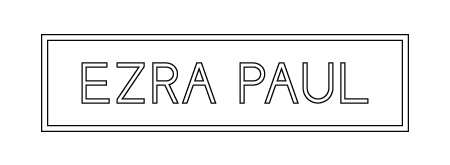What It Means To Be a Designer
Since I started Ezra Paul Clothing in 2010, I have always had a hard time describing myself as a designer. When I meet someone and tell them what I do, the majority of the time that person will say something along the lines of “oh, you’re a designer”…and technically it’s true. But I have never felt comfortable labeling myself as such. It took me a while to understand why. I think people assume that I’m being humble by avoiding the designer moniker, but really there are two basic reasons:
- I did not attend design school – I understand the intricacies of menswear patterns, but I would never consider myself a patternmaker.
- “Designing” men’s dress clothing consists almost entirely of tweaking silhouettes and details of a garment with a long history – one that has existed in slight variations for over 100 years and in greater variation for many hundreds of years.
For example, describing a jacket to someone who had never seen one in 1916 wouldn’t be much different than how we’d describe it in 2016, yet clearly men’s dress has changed considerably.
Anatomy of a Jacket: The Basic Details
When discussing the design of a jacket, there are a few details that are essential to understanding how they have changed over time and how they differ from one another today:

- Collar – back piece of material that wraps around the neck.
- Lapel – front piece of material that drapes from the collar to the front of the jacket.
- Button stance – the top functioning button of the jacket, which marks the end of the lapel.
- Gorge – the opening where the collar and the lapel meet.Other details, such as shoulder padding and jacket length, require no explanation and I am not going to get into the actual construction in this post.
To even the casual observer, the fit of men’s clothing has clearly changed dramatically in the last 20 years. From the late 1980s through the mid-aughts, the cut was considerably fuller.
Exhibit A – Frasier – circa 1993 or 1994

NBC
*Caveat, I just want to say that I love Frasier. Smartest show on television…
The Crane boys were avid connoisseurs of early-mid 90s couture. And again, describing their suits and modern suits would be essentially the same. But clearly there are some differences.
- The point-to-point measurement of the jacket shoulder is much wider than today and a substantial shoulder pad is necessary to prop up the jacket as it extends past the wearer’s shoulder.
- The lapel width is quite wide.
- The gorge and button stance (can’t see here) are very low and the jacket length is very long (Niles is sitting on his jacket).
Fashion is Cyclical:
The 90s look is reminiscent of other eras, most notably the 1930s-40s:

Columbia Pictures
I started selling men’s clothing in 2001 and within a few years something was clearly changing. A certain subsection of men started wanting everything more fitted and that trend continued into the 2010s where what is described as a modern/trim/fitted jacket seems to have become the new standard. A higher gorge, narrower lapels (though they are moving back out again) higher button stance, shorter jacket, narrow/natural shoulder, and high-armhole are common features today.

Some people credit this to Mad Men and the general fascination with the 1960s. By the end of that decade the fit was about as similar to today as we’ve seen, but there are still some pretty big differences.
I’ve heard of men wearing slim suits derided as looking like they robbed Pee-Wee Herman’s wardrobe, but if anything his jacket looks big by today’s comparison:

Warner Bros.
All of this is a long way of explaining how the process of designing men’s jackets and dress clothing works. No one person can take credit for designing the jacket. There is an ongoing, collective history of changes and adjustments. Though men’s dress clothing is functionally the same as it has been for quite some time, the details and nuances can dramatically change the look. I don’t know if I will ever be fully comfortable calling myself a designer, but without doubt I am engaged in design.

Nice blog. Educating and entertaining.